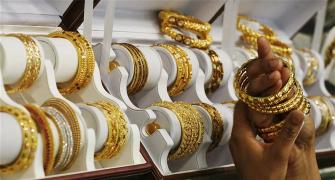While taking gold out of the closet to borrow money is no longer taboo in Indian households, the sharp drop in gold prices is hitting the newest loan product on the banking turf hard, explains Tamal Bandyopadhyay.

Till January, bank credit had shown a measly 5.7 per cent growth over the previous year.
The pace of growth in retail loans, the main driver of bank credit in India for the past few years, slowed down to 9.1 per cent year-on-year in January against 16.9 per cent a year ago.
But loan against gold, the new-found love of Indian bankers and borrowers, staged a phenomenal 132 per cent growth during this period.
From a low base of Rs 18,596 crore (Rs 185.96 billion), the industry's gold loan portfolio zoomed to Rs 43,141 crore (Rs 431.41 billion). This pace of growth is unlikely to sustain.
In the past few weeks, quite a few advertisements have been put out in newspapers by banks and non-banking financial companies (NBFCs) on gold auctions. The lenders are selling gold to recover dues from their borrowers.
Some bankers, in private, are saying they are seeing the first signs of rising defaults.
To be sure, such cases are not alarmingly high, but the bankers who had been aggressively hawking gold loans till recently are shifting gear; their focus now is more on managing risks of such loans than growth.
A sharp drop in gold prices is behind the change in their strategy.
Gold prices are down close to 20 per cent from the record high of Rs 55,922 in India early August 2020.
Since January, the prices are down by almost Rs 6,000. In the second week of March, the price dropped to a recent low of Rs 44,177; since then, it has risen around 1.5 per cent.
The drop in gold prices is at the root of the problem -- both for bankers and borrowers.
For instance, if a bank has given a loan of Rs 90,000 against Rs 100,000 worth of gold pledged (at 90 per cent loan-to-value or LTV -- the percentage of the loan that can be disbursed against the value of gold pledged), a 20 per cent drop in value increases the risk for the bank.
Why? The amount of loan given becomes higher than the value of the collateral.
In such a scenario, the borrowers are required to bring in more gold to add to the collateral or prepay the loan.
Some borrowers may not be able to replenish the collateral or don't have the money to close the loan.
A few smart ones even may choose not to pay back or bring in more gold (even though they have both) and decide to dump the gold already pledged, with the bank, as its value is less than the money taken from the lender.
This is why probably we are seeing gold auctions.
Of course, most banks are conservative and ask for higher margin, but if gold prices continue to fall, the problem will exacerbate.
In the past one year, most banks and NBFCs have been aggressively pushing for gold loans.
The State Bank of India's gold loan portfolio jumped to Rs 17,492 crore (Rs 174.92 billion) in December, rising from Rs 11,509 crore (Rs 115.09 billion) in just three months since October 2020.
The nation's largest lender is offering gold loans at 7.5 per cent.
One needs to simply dial a number to get all information about the product at SBI.
The bank also reaches out to customers, basis a missed call or a text message.
Most lenders have adopted a similar strategy.
Offering loans against gold has traditionally been the business of a handful of NBFCs such as Muthoot Finance Ltd, Manappuram Finance Ltd and Muthoot Fincorp Ltd.
But banks and even small NBFCs started grabbing the opportunity with both hands last year as consumers, including those at the so-called bottom of the pyramid, had shed their inhibition and were willing to monetise gold by taking loan when their cash flows dried up in a shrinking economy, hit by the Covid pandemic.
Muthoot Finance, which had a gold loan portfolio of Rs 37,724.5 crore (Rs 377.245 billion) in December 2019, has seen it rising to Rs 49,622.5 crore (Rs 496.225 billion) in December 2020.
During this period, its gold holding actually came down -- from 173 tonnes to 166 tonnes -- because of the drop in gold prices.
During this period, Manappuram Finance's gold loan portfolio had risen from Rs 16,242.95 crore (Rs 162.4295 billion) to Rs 20,211.48 crore (rs 202.1148 billion) but the gold holding dropped from 73.5 tonnes to 68.2 tonnes.
The NBFCs follow a lower LTV ratio for such loans.
These two are established gold-lending NBFCs.
Among the lesser known ones, Kochi-based Indel Money Pvt Ltd has been giving such loans to micro, small and medium enterprises.
Indiagold, a start-up founded by two former senior employees of a payments bank, now plans to go beyond Delhi, its home market, and roll out operations across India.
A January 2020 report of consultancy firm KPMG pegs informal lenders' share in the $46 billion gold loan industry at 65 per cent.
By its estimate, India's gold loan market is set to expand by at least 34 per cent to $61 billion in two years to March 2022.
This may, however, not happen even though there are many benefits for borrowers who can get the loans in the comfort of their homes or through on-line channels.
When a consumer asks for a gold loan, she gets a free valuation of the gold that she offers as collateral.
Besides, as the lender keeps the gold in its vault, it's free safe-keeping of the borrower's assets.
The financing is immediate if the purity of gold is certain, and the cost of gold loan is relatively cheaper compared with other loans.
The traders typically take gold loans as bridge financing to take care of temporary cash flow mismatches; individuals go for it for emergencies, particularly medical needs.
The household gold holding in India, the second biggest consumer of gold after China, could be as much as 25,000 tonnes.
The pandemic had led to a 94 per cent drop in gold import during the first quarter of 2020-21 but the scene has changed.
In February, gold import surged almost 124 per cent after a near 155 per cent rise in January.
The obsession for the yellow metal continues.
While taking it out of the closet to borrow money is no longer taboo in Indian households, the sharp drop in gold prices is hitting the newest loan product on the banking turf hard.
In August 2020, the Reserve Bank of India raised the LTV for gold loans to 90 per cent, effective till March 2021.
Gold prices were at record high at that time. It's time to revise the LTV downwards for de-risking the banks.
Tamal Bandyopadhyay, a consulting editor with Business Standard, is an author and senior adviser to Jana Small Finance Bank Ltd.
Feature Presentation: Aslam Hunani/Rediff.com










